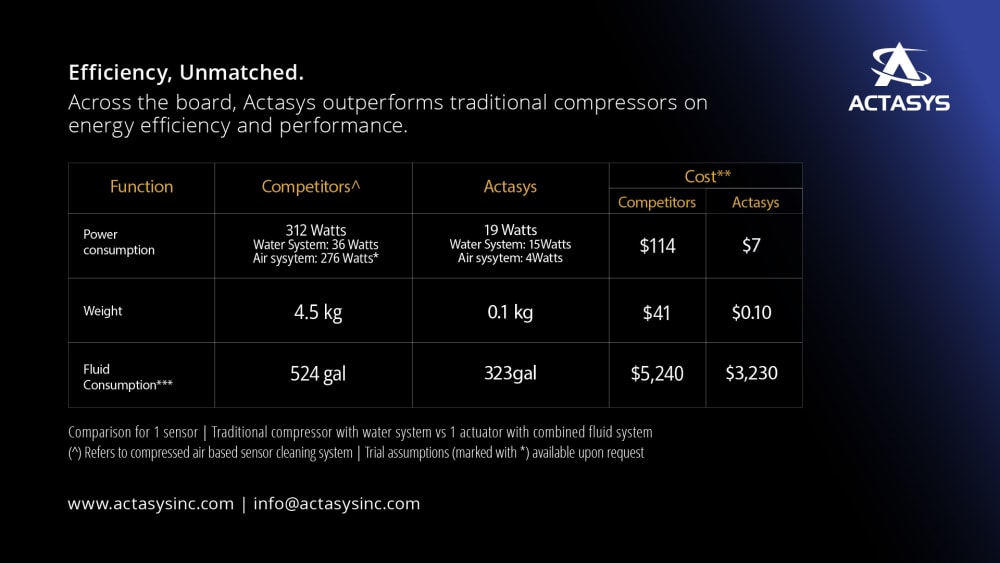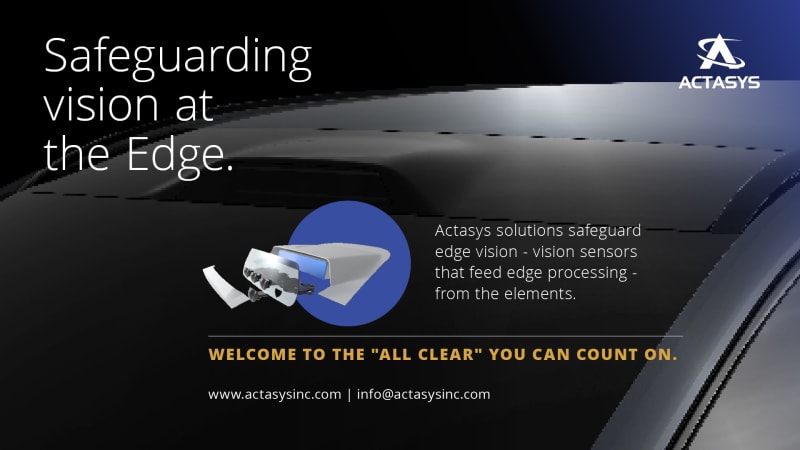
The future of automotive safety depends on sensor reliability, and sensor reliability depends on Actasys.
Truly safe ADAS and autonomous driving applications require real-time, high-quality data. The sensors that provide this data are approaching levels of power and precision that border on superpowers. Yet, few in the industry are considering how even the most sophisticated sensors remain vulnerable to physical obstructions, thermal imbalances, and misalignments, risking data inaccuracy and system failure. Ultimately for autonomous driving to become a safe reality in any possible weather and environmental condition, a reliable, effective, and resource efficient cleaning solution is crucial.
Actasys safeguards vision sensor functionality under even the harshest conditions. Our solutions assess sensor cleanliness and thermal conditions, evaluate performance, correct functional impairment through responsive cleaning and/or cooling applications, and report on sensor functionality - all in real time. The energy-saving and integration-friendly design works within existing architectures, allowing OEMs and Tier 1s to build for today and innovate for tomorrow.
At the heart of our system lies our proprietary actuator, a cutting-edge electronic disc only 3mm thick, which utilizes two piezoelectric-driven membranes to generate a pulsating air jet. Like lungs, the expanding and contracting of the membranes draws in and expels the air without pipes or a compressor. This approach offers distinct advantages over conventional fans or compressed air systems. The actuation frequency and the irregular vorticity that characterize the air jet are much more effective both exciting droplets/debris (destabilizing them for removal from an optical surface) and penetrating thermal boundary layers, optimizing air mixing to achieve superior cooling with unmatched efficiency.
Further, the actuator’s solid-state eliminates risks associated with mechanical parts, offering reliability and durability. Our architecture simplifies infrastructure requirements, relying solely on electric wires and data transmission while significantly enhancing water spray distribution efficiency. This improves cleaning effectiveness against denser contamination and has the potential to drastically reduce the quantity of water needed, which in turn reduces costs and saves on weight and space. The smart software component provides ongoing insight into sensor health and maintenance requirements, ensuring efficiency and optimization across the sensor life cycle.
The impact?
End-users benefit from continuous vision sensor performance, ensuring safety and accuracy with insights for operational and maintenance optimization.
System integrators enjoy improved cleaning performance with simplified infrastructure requirements and reduced water and energy consumption.
Designers gain seamless integration, allowing for sensor placement flexibility without compromising aesthetics or aerodynamics.
Given that no automotive sensor cleaning standard exists, Actasys design and development are directly improving mobility safety across the industry. We’re actively engaged with advocacy, policy, regulatory, and standard-setting organizations, elevating thought framework development and guiding the establishment of industry-wide best practices.
Ours is a groundbreaking advancement in sensor vision maintenance that meets the demands of today’s automated vision applications, whether in robotics, smart cities, or autonomous vehicles. By providing continuous sensor performance, optimizing cleaning processes, and offering thermal management in an elegant, lightweight, and easily-integrated design, Actasys ensures enhanced safety, accuracy, and operational efficiency across industries.
Video
-
Awards
-
 2023 Top 100 Entries
2023 Top 100 Entries
Like this entry?
-
About the Entrant
- Name:David Menicovich
- Type of entry:individual
- Software used for this entry:Actasys has software with its system that performs three functions. First is to control and drive the device and allow it to communicate with other systems and components; second is to detect and quantify obscuration to inform the device as to what operating mode may be required for the conditions the sensor is experiencing; and, third is to provide reporting on system health, operation and maintenance requirements.
- Patent status:patent









